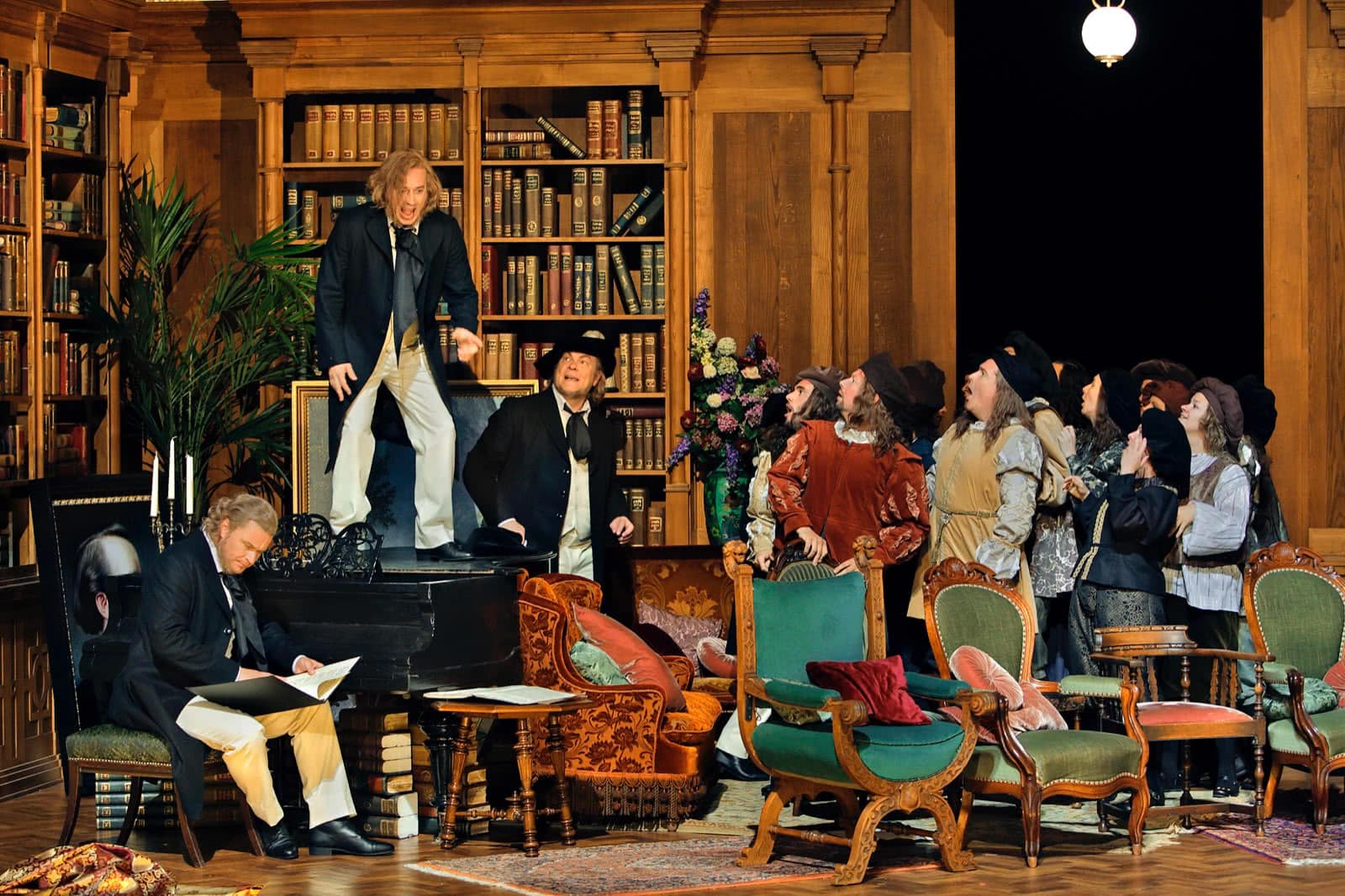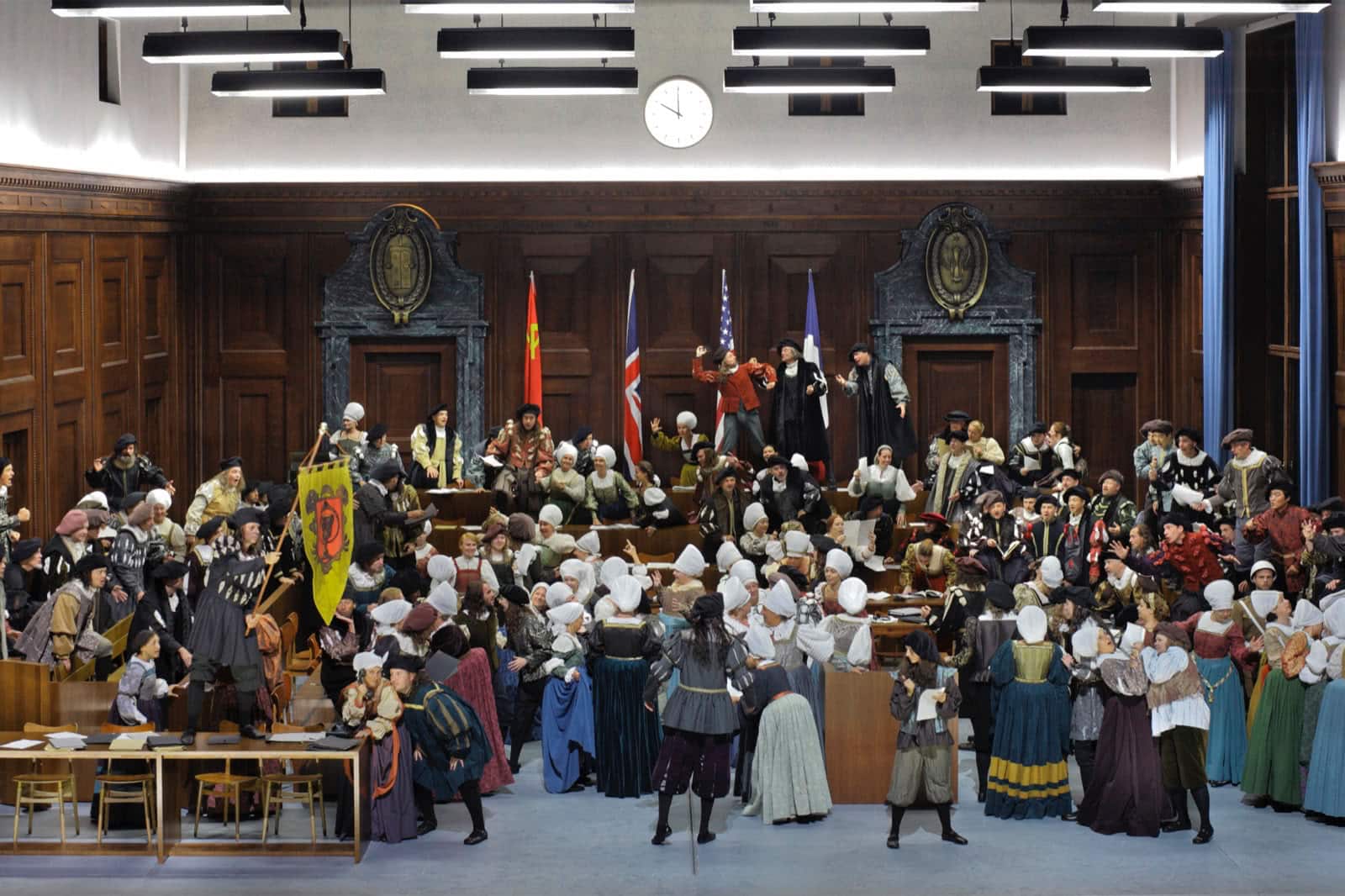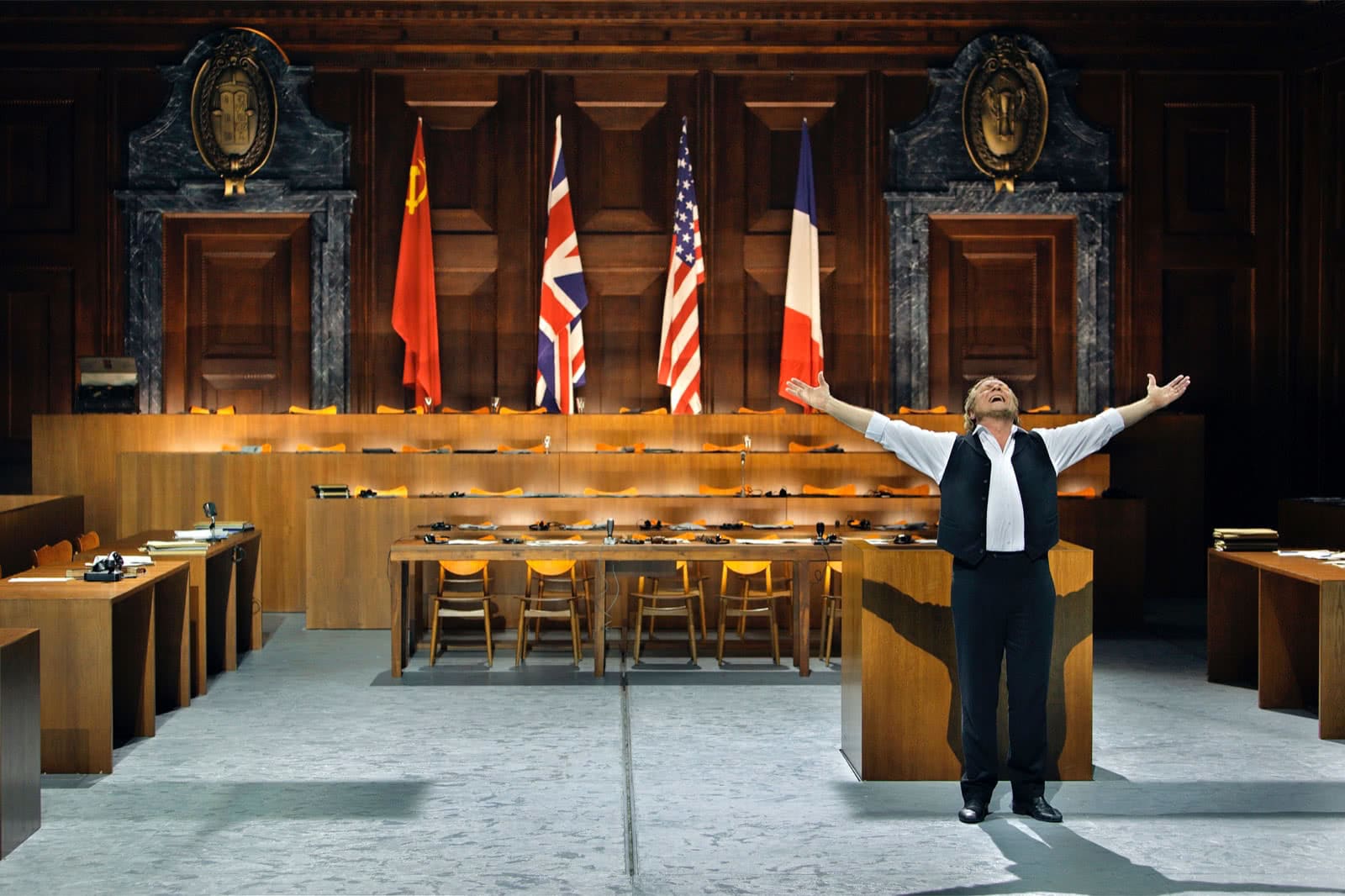A pogrom unfolds on the streets of Nuremberg. It’s the end of Act II of Barrie Kosky’s new production of “Die Meistersinger von Nürnberg” at the Bayreuth Festival. Elsewhere in the piece, Hans Sachs sings that “all poems and verse are just the interpretation of dreams.” In some sense this production represents Beckmesser’s dream, or nightmare. He is beaten with an enormous portrait of Wagner. His arm is broken, his head is kicked. A papier-mâché head—a hook-nosed, side-locked, yarmulke-wearing antisemitic stereotype—is placed on top of his own head and he is pushed and mocked, stumbling wildly as the crowd attacks him. An enormous, stage-sized balloon of the antisemitic head inflates and consumes the stage. The situation up until then has unfolded like any comic opera’s middle act: the heroine, Eva, has switched costumes with her maid so she can talk to her secret lover; her lover’s rival, Beckmesser, favored by her father but whom she hates, has been trying to serenade her but ended up singing for her maid. He himself has been foiled by another family friend, the town’s shoemaker and poet laureate, Sachs. The maid’s fiancé returns and calls the townspeople into the street, angrily accusing Beckmesser of seducing his bride-to-be. Then, the pogrom. As the crowd vanishes behind the enormous balloon, Beckmesser is left slumped, dejected, and alone. The audience’s last vision as the curtain closes is the Star of David on the balloon’s head.

The ease with which even an assimilated Jew can be consumed by stereotype, by nightmarish blood libel from the past; this gives that stage image its power. While Beckmesser’s character can be seen as a union of anti-Semitic and anti-critic stereotypes, the scene is usually played as a riot rather than a pogrom. On July 31, when I attended, that act’s conclusion was greeted with scattered but vehement boos that were themselves shouted down by praise. It could not have been otherwise: “Die Meistersinger” is a work that sits precisely at the intersection between great art, German nationalism, and that nationalism’s murderous consequences. Intended as both light comedy and composer-poet Wagner’s own artistic and political self-justification, it uses the story of a song contest in a mythical medieval Nuremberg to explore art and ethnicity’s related utility in the creation of groups both in and out. A merchant, Pogner, will marry his daughter Eva to the winner of a contest open to all members of the town’s guild of master singers. A young knight new to town, Walther von Stolzing, has already fallen for her, and she him. He tries to join the guild but is stymied by strict rules and the group’s marker and house critic, Beckmesser, who wishes to win Eva for himself. With the aid of Sachs, he learns to unify his genius with the rules and produces, by the end, a song that fuses innovation with tradition. They wed. Meanwhile, Beckmesser, a, let’s say, “rootless cosmopolitan” unable to harness the pure strains of German art, tries to steal a copy of the song and, after performing it poorly, is humiliated and run out of town. Sachs concludes the piece by warning townspeople and audience of the dangers of foreign influence and begs them to unify tradition and innovation, to hold fast to what is German and true.
Kosky’s proposition is that Wagner’s ideology—his conception of the ethnic German Volk as a pure race that needed protection and guidance, an attendant and vicious antisemitism that viewed Jews as a threat to its honor, and his explicit presentation of himself, his art, and his descendants as its masters and defenders—is an inexorable part of his work, especially “Meistersinger,” and must be confronted directly. In his director’s statement, Kosky writes, “There are people who belong in Nuremberg and people who do not belong. They must be removed, so we can’t see them, hear them or remember them.” Nuremberg, he points out, is the city of mythic guild rule and Albrecht Dürer as well as the city of race laws and postwar tribunals. He continues: “[‘Die Meistersinger’] is full of heart-breaking moments of beauty and melancholy. It is full of genuine and authentic expressions of life and joy and happiness. But it is also troubled and troubling. It just depends on who you are in the piece and who you are in the audience.” Without granting it an inch, Kosky acknowledges what is enchanting about the Wagner cult, at least for those who are included in its vision of artistic and racial wholeness.
Those who don’t know the piece may read that description and ask why anyone would perform it at all. The answer: it may be Wagner’s greatest work, full of humor and joy and gorgeous music. Crucial to note is the extent to which the piece’s comedy and humanity shine through in this production. Within the concept, all the interpersonal relationships function: everyone is recognizably human, every theatrical action has a plausible reaction. Addressing the poison allows what is beautiful in the piece to flourish.
As the overture begins, the curtain rises on Wahnfried, Wagner’s villa where he lives with his wife, Cosima. Her father, the composer Franz Liszt, is coming for a visit. Wagner bustles in with dogs on leash, opens gifts, greets Liszt and another guest, the Jewish conductor Hermann Levi, whom Wagner urged to accept baptism before he could conduct his final opera, “Parsifal.” Liszt and Wagner play some sections of the overture four-hands on the piano (cleverly timed to burbling wind chorales). The chairs are arranged into a semicircle and the assembled begin to read through the score of “Meistersinger.” Cosima becomes Eva, daughter of Liszt’s Pogner. Sachs is Wagner himself, as are Walther and Sachs’ apprentice David, who emerge identically clad out of the piano. The other masters, dressed like extras in a Dürer painting, burst in through side doors. Levi, after much pleading, is persuaded to don the gold chain and hat of Beckmesser. Gradually the Wagner-family costumes fade away and the characters take shape in traditional dress. The final image of Act I, after Walther fails his first test, sees Wahnfried’s interior slowly recede into a courtroom. When its final wall descends, carrying the flags of the four Allied powers, we realize this is the courtroom of the Nuremberg trials. This, with the addition and later removal of grass in Act II, is the set for the remainder of the piece. To the piece’s series of artistic trials, a political one is added.

Musically this was an extraordinary evening. Conductor Phillipe Jordan led a lean, fluent performance attentive to musical detail and dramatic possibility, sensitive to rhythms of speech in a way that allowed the comedy to burst off the stage. Balance and intonation were impeccable throughout: every tone of every chord was audible, Wagner’s brilliant Bachian voice-leading illuminated from within. Low strings greeted Sachs’ great monologues like sharp intakes of breath. Michael Volle, as Sachs, sang this longest of all Wagnerian roles with authoritative, rich tone, extraordinary intonation, and a keen textual intelligence. His cries of Wahn, delusion, seemed to hang in the humid air of the Festspielhaus long after they had faded. Dramatically, he lived up to Kosky’s superhuman requirements, presenting a Sachs-as-Wagner who could inspire laughter, respect, and fear depending on the moment. Klaus Florian Vogt, by now an old hand at the part of Walther, applied his heady, slightly nasal tenor to the role with insightful, improvisatory phrasing. Rather than blasting through the orchestra with force, he invited the audience to lean in closer. Johannes Martin Kränzle’s Beckmesser, reconceived at the emotional and dramatic center of the work, was gorgeously sung without burlesquing; dramatically, he conveyed the character’s interpellation of antisemitic attacks and deep desire to be accepted as a member of the cultural and artistic community that mocks and rejects him. Slightly below the level of most of the main cast was Anne Schwanewilms as a peripatetic Eva (and Cosima); despite some moments of beautiful phrasing, notably in the famous Act III quintet, the role sat uncomfortably in her high-flying soprano. Pogner, her father, was sung by the German bass Günther Groissböck with sensitivity and enormous, Sachs- and Wotan-ready sound. The smaller side roles of David and Magdalene received warm and sympathetic readings from, respectively, Daniel Behle and Wiebke Lehmkuhl.
The latest from VAN, delivered straight to your inbox
As the production ends, Walther-as-Wagner sings the Prize Song from the Nuremberg Trials’ witness stand. Eva moves in to join him and the crowd hails them. Beckmesser, having sung the song incoherently due to his inability to access the true spirit of art, or Germanicity (for Wagner there is little difference), has long since been dragged out a side door, never again to be seen or spoken of. The crowd disperses, and Sachs-as-Wagner takes the stand. In an empty courtroom, he rants, warning the audience to heed their artistic masters. As the monologue takes on a disturbing, nationalistic tone, with Sachs warning of foreign influences sullying holy German art, the back wall of the courtroom rises and an orchestra, played by a seated and miming chorus, moves towards him. He turns to conduct them, at which moment they begin to recede. The final image, to Wagner’s triumphant brass chorales, is of Sachs conducting alone in an empty courtroom. Blackout. Finally the audience is asked to judge: What value do we give the poisonous words of this raving idiot? And to what extent does the greatness of his music, and the humanity and generosity he has shown earlier in the piece, redeem him?
In 1951, fresh off summers at Wahnfried with Uncle Adolf, Wagner’s grandsons Wolfgang and Wieland pled audiences to focus on the Art, using Eva’s line to Sachs from Act III: Hier gilt’s der Kunst, art is what matters here. At Wahnfried, where devoted groups of Wagnerians still arrange for wreaths of fresh flowers to be delivered daily to the Master’s grave, a photograph hangs. Taken in 2008, it shows the aged Wolfgang surrounded by applauding members of his family, including Katharina Wagner, who currently runs the festival, and her half-sister Eva, who used to co-direct with Katharina but two years ago was first dismissed and then banned from attending. Her rumored adversary Christian Thielemann, now the festival’s music director, who in the photograph hovers awkwardly over Katharina’s shoulder, as if by some triumph of the will he might be able to join the sacred clan. This new “Meistersinger” replaces a 2007 flop directed by Katharina. Her production attempted to address the work’s problematic ideology but was roundly criticized as incoherent and inane. Later that year, her last name propelled her to the festival’s directorship. Hier gilt’s der Kunst.

There is something extraordinary-feeling about the Bayreuth Festival: its uncomfortable seats, the sense of privilege and interest in every audience member, how the theater’s acoustic and architectural design pull the viewer into the stage. Low brass and strings rumble in the orchestra pit and feel as though they’re moving your seat. Countesses in boas abound. The whole place is strange and unique—unified—in a way that few music festivals are. Each component feels individually expressive in an increasingly homogenized world. But especially after Kosky’s intervention it is impossible to visit the Festspielhaus or Wahnfried or stroll through the city’s baroque streets without thinking of the extent of the family’s willing collaborationism or the extent to which the intellectual justifications for it still stand.
In Kosky’s production, before Walther sings his prize-song and Beckmesser is ostracized, David, dressed as Wagner, carries a portrait of Cosima into the witness stand, bows to it, and kisses it on the lips. He ushers on a series of successively smaller Wagners, all of whom bow to and kiss the portrait. The family is on trial too, and they have no great music with which to defend themselves. It is true the smaller Wagners have invited Barrie Kosky to direct this “Meistersinger,” but should these confrontations still be happening on their terms? ¶
Subscribers keep VAN running!
VAN is proud to be an independent classical music magazine thanks to our subscribers. For just over 10 cents a day, you can enjoy unlimited access to over 875 articles in our archives—and get new ones delivered straight to your inbox each week.
Not ready to commit to a full year?
You can test-drive VAN for one month for the price of a coffee.


Comments are closed.